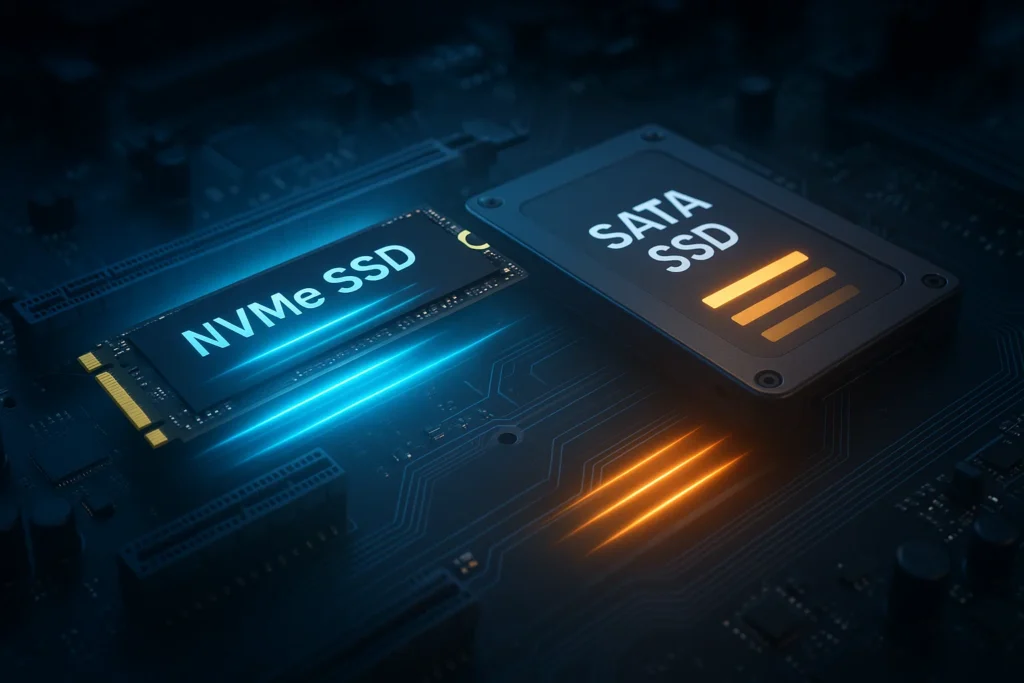
Top 10 Benefits of NVMe Over SATA and SAS – Why PCIe SSDs Matter
In today’s fast-paced digital world, storage performance plays a critical role in ensuring system responsiveness, application efficiency, and data management. Technologies have rapidly evolved, and the shift from traditional storage interfaces like SATA and SAS to NVMe is gaining significant traction. But what exactly makes NVMe over SATA so revolutionary? Why does PCIe matter in this transition?
This article breaks down the major benefits of NVMe technology compared to SATA and SAS and highlights why PCIe is the backbone of this performance leap.
NVMe, SATA, and SAS Interfaces
Before diving into the benefits, it’s essential to understand the core difference between NVMe, SATA, and SAS interfaces.
-
SATA (Serial ATA) was designed for spinning hard drives and capped at around 600 MB/s.
-
SAS (Serial Attached SCSI) is generally used in enterprise setups with better error handling and speeds than SATA, but it’s still limited.
-
NVMe (Non-Volatile Memory Express) is built specifically for SSDs using the PCIe interface. It takes advantage of parallelism and lower latency to outperform both SATA and SAS dramatically.
Unlike SATA and SAS, NVMe communicates directly with the CPU, reducing bottlenecks and delivering exceptional speed.
Blazing-Fast Data Transfer Speeds
One of the most evident benefits of NVMe over SATA is its superior speed. NVMe SSDs can easily reach read and write speeds exceeding 3500 MB/s, compared to the 550 MB/s typical for SATA SSDs. This speed translates to faster boot times, quick file transfers, and seamless application performance.
Whether you’re working with 4K video editing, large databases, or real-time analytics, NVMe’s speed can be a game-changer.
Lower Latency and Better Responsiveness
Latency is a critical factor in user experience, particularly in I/O-heavy applications. NVMe over SATA provides significantly lower latency due to its streamlined command set and direct communication via PCIe lanes.
While SATA uses the older AHCI protocol designed for spinning disks, NVMe was engineered for flash-based storage, eliminating unnecessary overhead. This results in faster access times and enhanced responsiveness in high-performance workloads.
Scalability for Future Demands
Modern applications and workloads demand storage solutions that scale efficiently. NVMe over SATA offers incredible scalability by leveraging multiple PCIe lanes ranging from x1 to x16, allowing it to meet the demands of AI, machine learning, and big data environments.
Unlike SATA, which supports only one command queue with 32 commands, NVMe supports 64K queues with 64K commands each. This makes NVMe ideal for data centers and high-performance computing applications.
Parallel Processing Capabilities
The architecture of NVMe allows multiple I/O queues to process simultaneously, vastly improving throughput. This multi-threaded capability is something SATA and SAS struggle with due to their serialized command structure.
With NVMe over SATA, users benefit from real-time data handling, reduced bottlenecks, and more efficient resource utilization, especially important in multi-user and virtualized environments.
Energy Efficiency and Thermal Management
Though faster, NVMe drives are also more power-efficient. Their ability to handle more data per watt means less energy is wasted. Many enterprise-grade NVMe SSDs include power-saving modes and thermal throttling to manage heat without compromising performance.
SATA and SAS, by contrast, often generate more heat for the same amount of workload due to their less efficient protocols and architecture.
Compact and Flexible Form Factors
NVMe drives are available in several form factors, including M.2, U.2, and PCIe add-in cards. Their small size and flexible installation options make them suitable for ultra-thin laptops, compact servers, and embedded systems.
SATA and SAS are bulkier and less adaptable to modern hardware configurations, which often prioritize space-saving designs.
Improved Reliability and Endurance
Thanks to better error handling and advanced wear-leveling algorithms, NVMe SSDs tend to offer improved reliability and longer lifespans. Enterprise-grade NVMe drives often come with high TBW (terabytes written) ratings, making them ideal for sustained heavy workloads.
In contrast, many SATA and SAS SSDs are not built to endure prolonged high-write environments.
Seamless Integration with Modern Operating Systems
Modern operating systems like Windows 10/11, Linux, and macOS offer native support for NVMe, enabling out-of-the-box functionality. This minimizes driver conflicts and allows for easy deployment in both personal and enterprise environments.
SATA and SAS, while also supported, require additional configuration and drivers for optimal performance, especially in server scenarios.
Perfect for High-Performance Computing and Gaming
For gamers and content creators, NVMe over SATA offers a noticeable performance uplift. Game load times are significantly reduced, and large media files can be edited or transferred without lag.
In high-performance computing, NVMe enables real-time processing and analytics, driving innovation across industries like finance, healthcare, and logistics.
Why PCIe Makes All the Difference
The true power of NVMe lies in its use of PCIe lanes. PCIe (Peripheral Component Interconnect Express) provides a high-speed interface for data transfer between storage and CPU. The more lanes NVMe can access, the faster and more efficiently it performs.
This is why the choice to buy a PCIe SSD is crucial for professionals and enthusiasts looking to maximize their system’s potential. PCIe not only boosts speed but also ensures future compatibility with emerging technologies.
Cost Consideration vs. Performance
Though NVMe SSDs are more expensive than their SATA counterparts, the performance gains often justify the price, especially for mission-critical tasks. As NVMe becomes more widespread, costs are gradually decreasing, making it a viable option for even budget-conscious consumers.
Additionally, the reduced latency and higher efficiency can lower operational costs in the long run, particularly for enterprise applications.
Final Thoughts on NVMe Over SATA
When evaluating storage solutions, the superiority of NVMe over SATA is evident. From faster speeds and lower latency to better scalability and energy efficiency, NVMe stands as the modern standard for high-performance storage.
With the continued evolution of PCIe standards, NVMe’s potential will only grow, cementing its place in both consumer and enterprise environments. Whether you’re upgrading a laptop, building a gaming rig, or managing a data center, NVMe offers unmatched benefits that make it well worth the investment.
FAQs
What makes NVMe faster than SATA and SAS?
NVMe uses PCIe lanes for direct communication with the CPU, while SATA and SAS rely on slower protocols like AHCI. This enables NVMe to deliver significantly higher data transfer speeds and lower latency.
Is NVMe more reliable than SATA SSDs?
Generally, yes. NVMe SSDs often come with advanced wear-leveling and error correction mechanisms that improve endurance and reliability under sustained workloads.
Can I replace a SATA SSD with an NVMe SSD?
Only if your motherboard supports NVMe via M.2 or PCIe slots. Always check compatibility before upgrading to avoid installation issues.
Is NVMe worth the extra cost?
For users dealing with large files, gaming, or high-performance computing, the added cost of NVMe is justified by its massive speed and efficiency benefits.


